Enhancing Damage-Sensing Capacity of Strain-Hardening Macro-Steel Fiber-Reinforced Concrete by Adding Low Amount of Discrete Carbons
Abstract
:1. Introduction
2. Experimental Test
2.1. Materials and Preparating Specimens
2.2. Test Setup and Procedure
3. Results and Discussion
3.1. Influence of Additive Type on the Electrical Resistivity of MSFRCs
3.2. Effects of Humidity and Temperature on Electrical Resistivity of MSFRC
3.3. Effects of Carbon Fiber Volume Fraction on the Electro-Tensile Behavior of MSFRCs
- In the first stage, under a low tensile load applied, the micro fibers can bridge small air bubbles and limit the crack propagation. The interfacial zone around the macro fiber is stronger with support from the micro fiber.
- In the second stage, as the crack slit through the section appears, both the micro and the macro fiber bridge the crack slit together but the macro is thought to play the main role. Park et al. [26] stated that the macro fiber mainly serves to enhance the ductility of composites while the micro fiber serves to improve the post-cracking strength.
3.4. Damage-Sensing Capabilities of Some MSFRCs in Review
3.5. Effects of MWCNTs on the Electro-Tensile Behavior of MSFRCs
4. Conclusions
- From same plain mortar, adding conductive additives clearly affected the electrical resistivity of MSFRCs. The order of studied MSFRCs in term of the electrical resistivity was ranked as follows: steel smooth fibers 1.0% volume content blended MWCNTs < hybrid fibers 1.5% volume content < steel smooth fibers 1.5% volume content < no conductive fibers or conductive powders. This means that the MWCNTs strongly enhanced the electrical conductivity of MSFRCs.
- The low electrical resistivity of the MSFRCs was not accompanied by a high damage-sensing capacity that is strongly dependent on the relative change in resistivity.
- The environmental condition clearly affected the electrical resistivity of MSFRCs; as the relative humidity or temperature increased, there was an important reduction in electrical resistivity of MSFRCs.
- Adding 0.5% volume fraction of carbon fibers in initial MSFRC1 or MSFRC2, containing 1.0% and 1.5% volume content of long smooth fibers, respectively, produced the highest gauge factor, i.e., the highest damage-sensing capability. Furthermore, MSFRC1 was more sensitive to the additional carbon fiber than MSFRC2.
- The high volume content of carbon fibers added may cause the reduction in gauge factor, specifically, the carbon fibers, in a hybrid system with steel fibers, should not exceed 0.5% volume fraction in order to disperse well and produce strain-hardening. The post-cracking resistances of MSFRC1 generally increased with addition of low volume content of carbon fibers, whereas those of MSFRC2 did not.
- Although ultra-high-performance concrete (matrix M2) can produce very high compressive strength as well as the highest post-cracking tensile strength, it might not produce a high gauge factor.
- Adding MWCNTs into original MSFRCs, with their fabrications described in this study, might not produce a favorable enhancement of mechanical resistance as well as damage-sensing capacity of MSFRCs, although their electrical resistivity would be significantly reduced.
Author Contributions
Funding
Conflicts of Interest
References
- Li, H.; Ou, J. The state of the art in structural health monitoring of cable-stayed bridges. J. Civ. Struct. Health Monit. 2016, 6, 43–67. [Google Scholar] [CrossRef]
- Han, B.; Ou, J. Embedded piezoresistive cement-based stress/strain sensor. Sens. Actuators A 2007, 138, 294–298. [Google Scholar] [CrossRef]
- Chung, D.D.L. Self-monitoring structural materials. Mater. Sci. Eng. 1998, R22, 57–78. [Google Scholar] [CrossRef]
- Chung, D.D.L. Electrically conductive cement-based materials. Adv. Cem. Res. 2004, 16, 167–176. [Google Scholar] [CrossRef]
- Chen, P.W.; Chung, D.D.L. Carbon-Fiber-Reinforced Concrete as an Intrinsically Smart Concrete for Damage Assessment during Dynamic Loading. J. Am. Ceram. Soc. 1995, 78, 816–818. [Google Scholar] [CrossRef]
- Chen, P.W.; Chung, D.D.L. Concrete as a new strain/stress sensor. Compos. Part B Eng. 1996, 27, 11–23. [Google Scholar] [CrossRef]
- Chung, D.D.L. Piezoresistivity cement-based materials for strain sensing. J. Intell. Mater. Syst. Struct. 2002, 13, 599–609. [Google Scholar] [CrossRef]
- Wen, S.H.; Chung, D.D.L. A comparative study of steel- and carbon-fiber cement as piezoresistive. Adv. Cem. Res. 2003, 15, 119–128. [Google Scholar] [CrossRef]
- Naaman, A.E.; Reinhardt, H.W. Characterization of high performance fiber reinforced cement composites. In High Performance Fber Reinforced Cement Composites: HPFRCC 2, Proceedings of the 2nd International Workshop on HPFRCC; E.& FNSpon: London, UK, 1996; pp. 1–24. [Google Scholar]
- Kim, D.J.; El-Tawil, S.; Naaman, A.E. Rate-dependent tensile behavior of high performance fiber reinforced cementitious composites. Mater. Struct. 2009, 42, 399–414. [Google Scholar] [CrossRef]
- Nguyen, D.L.; Ryu, G.S.; Koh, K.T.; Kim, D.J. Size and geometry dependent tensile behavior of ultra-high-performance fiber-reinforced concrete. Compos. Part B 2014, 58, 279–292. [Google Scholar] [CrossRef]
- Nguyen, D.L.; Kim, D.J.; Ryu, G.S.; Koh, K.T. Size effect on flexural behavior of ultra-high-performance hybrid fiber-reinforced concrete. Compos. Part B 2013, 45, 1104–1116. [Google Scholar] [CrossRef]
- Nguyen, D.L.; Thai, D.K.; Kim, D.J. Direct tension-dependent flexural behavior of ultra-high-performance fiber-reinforced concretes. J. Strain Anal. Eng. Des. 2017, 52, 121–134. [Google Scholar] [CrossRef]
- Nguyen, D.L.; Song, J.; Manathamsombat, C.; Kim, D.J. Comparative electromechanical damage-sensing behavior of six strain-hardening steel-fiber-reinforced cementitious composites under direct tension. Compos. Part B 2015, 69, 159–168. [Google Scholar] [CrossRef]
- Song, J.; Nguyen, D.L.; Manathamsombat, C.; Kim, D.J. Effect of fiber volume content on electromechanical behavior of strain-hardening steel-fiber-reinforced cementitious composites. J. Compos. Mater. 2015. [Google Scholar] [CrossRef]
- Kim, M.K.; Kim, D.J.; An, Y.K. Electro-mechanical damage self-sensing behavior of ultra-high-performance fiber-reinforced concrete. Compos. Part B 2018, 134, 254–264. [Google Scholar] [CrossRef]
- Li, M.; Lin, V.; Lynch, J.; Li, V.C. Multifunctional carbon black engineered cementitious composites for the protection of critical infrastructure. High Perform. Fiber Reinf. Cem. Compos. Proc. Int. Workshop (Hpfrcc6) 2012, 2, 99–106. [Google Scholar]
- Ranade, R.; Zhang, J.; Lynch, J.; Li, V.C. Influence of micro-cracking on the composite resistivity of Engineered Cementitious Composites. Cem. Concr. Res. 2014, 58, 1–12. [Google Scholar] [CrossRef]
- Nguyen, D.L.; Vuong, T.N.H.; Nguyen, T.T. Additional carbon dependent electrical resistivity behaviors of high performance fiber-reinforced cementitious composites. In Proceedings of the 4th Congrès International de Géotechnique—Ouvrages—Structures, Ho Chi Minh City, Vietnam, 26–27 October 2017; pp. 310–318. [Google Scholar]
- Nguyen, D.L.; Kim, D.J. Self damage sensing of fiber reinforced cementitious composites using macro-steel- and micro-carbon-fibers. In Proceedings of the 6th International Conference on Engineering and Applied Sciences, Hong Kong, China, 8–10 June 2016; pp. 144–152. [Google Scholar]
- Nguyen, D.L.; Kim, D.J. Effect of temperature and relative humidity on electrical resistivity of fiber reinforced concretes. In Proceedings of the Korea Concrete Institute (KCI) Conference-Fall, Muchangpo, Korea, 21–24 September 2014; pp. 735–736. [Google Scholar]
- Wittmann, F.H. Observation of an electromechanical effect of hardened cement paste. Cem. Concr. Res. 1973, 3, 601–605. [Google Scholar] [CrossRef]
- Wen, S.H.; Chung, D.D.L. Electric polarization in carbon fiber reinforced cement. Cem. Concr. Res. 2001, 31, 141–147. [Google Scholar] [CrossRef]
- Cao, J.; Chung, D.D.L. Electric polarization and depolarization in cement-based materials, studied by apparent electrical resistance measurement. Cem. Concr. Res. 2004, 34, 481–485. [Google Scholar] [CrossRef]
- Richard, A.B.; David, H.W. The dependence of resistance on temperature for metals, semiconductors, and superconductors. J. Chem. Educ. 1997, 74, 1090. [Google Scholar] [CrossRef]
- Park, S.H.; Kim, D.J.; Ryu, G.S.; Koh, K.T. Tensile behavior of ultra high performance hybrid fiber reinforced concrete. Cem. Concr. Compos. 2012, 34, 172–184. [Google Scholar] [CrossRef]
- Chung, D.D.L. Dispersion of short fibers in cement. J. Mater. Civ. Eng. 2005, 17, 4. [Google Scholar] [CrossRef]
- Yan, X.; Tay, B.K.; Yang, Y. Dispersing and functionalizing multiwalled carbon nanotubes in TiO2 Sol. J. Phys. Chem. B 2006, 110, 25844–25849. [Google Scholar] [CrossRef] [PubMed]
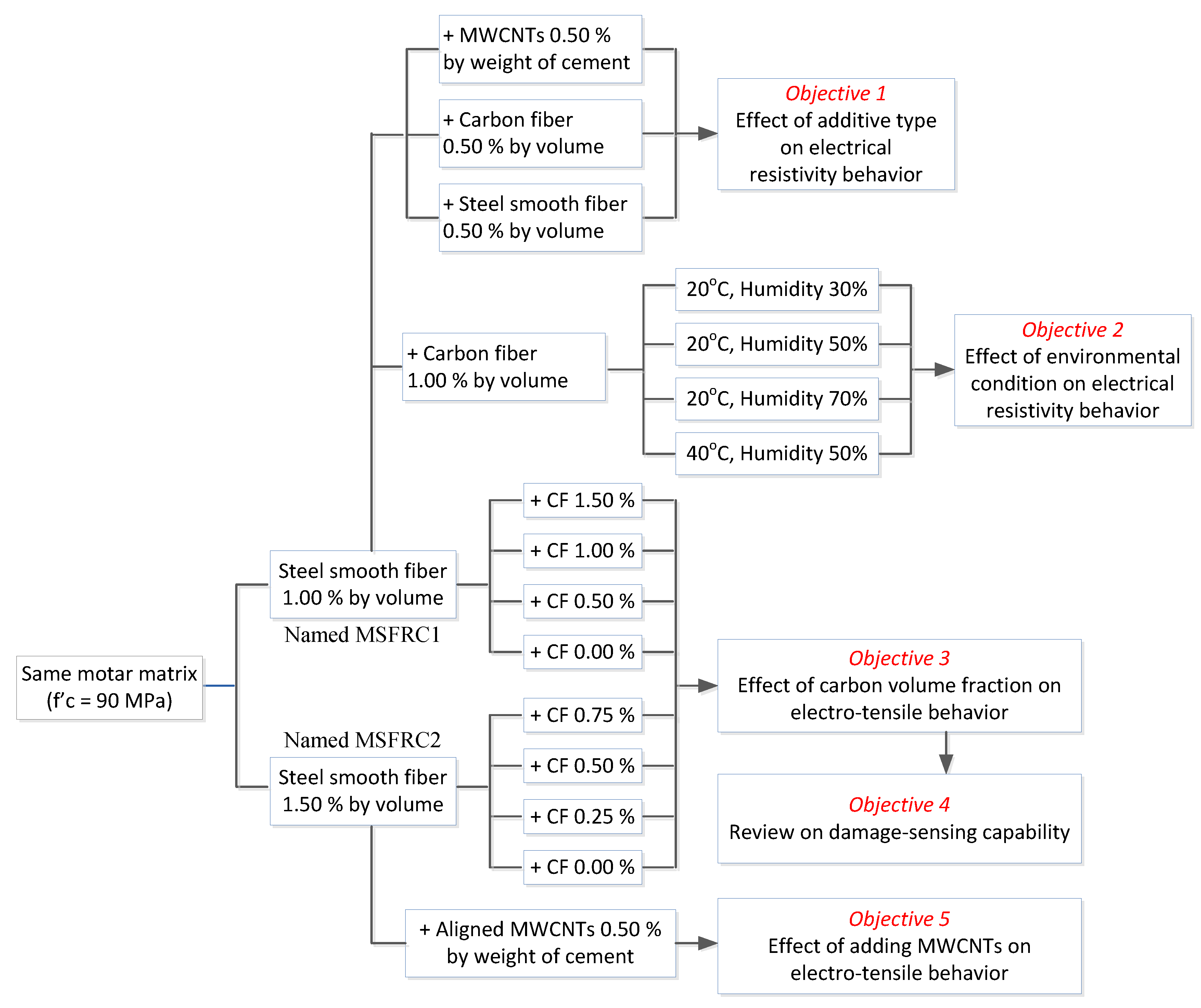

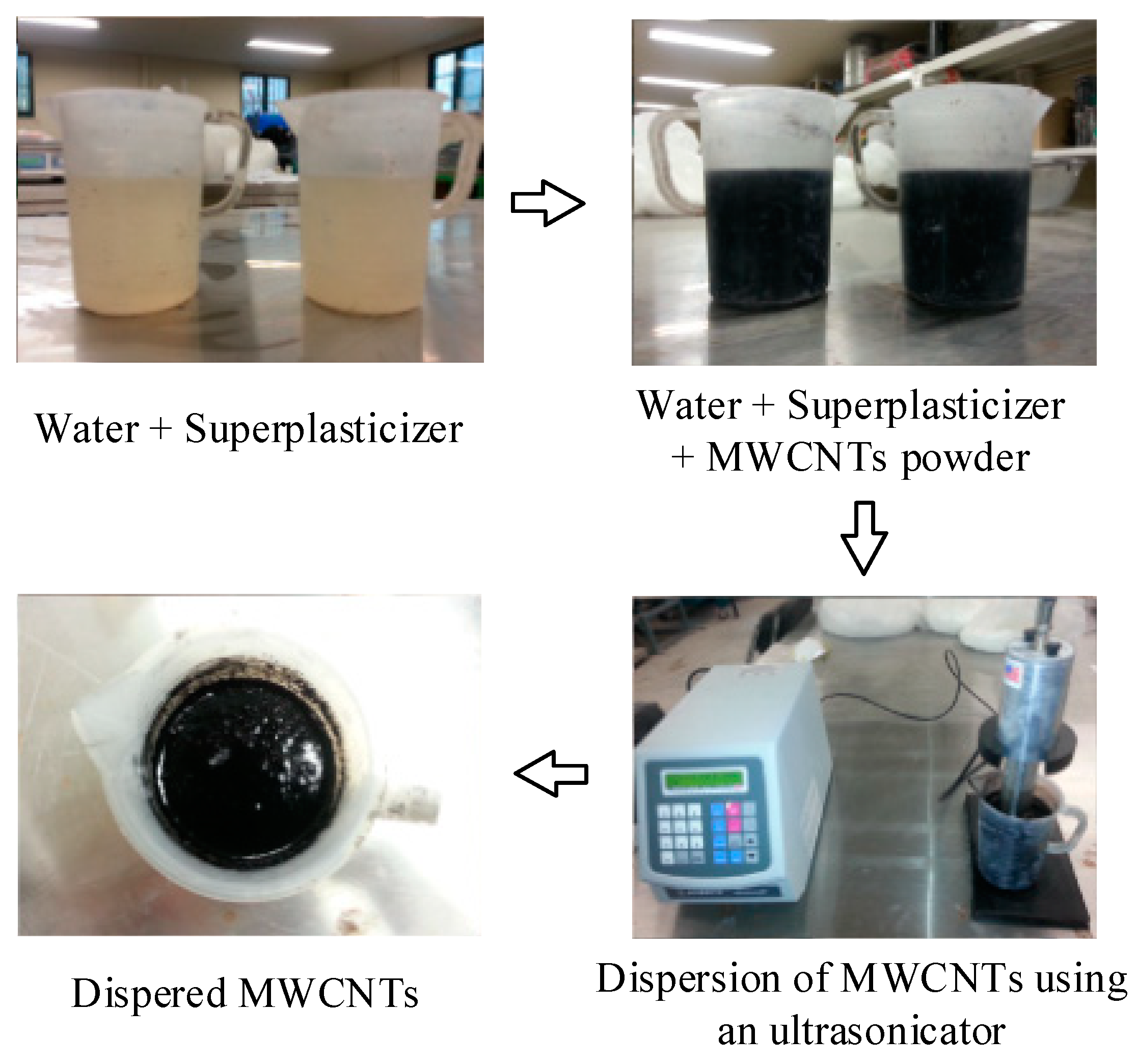
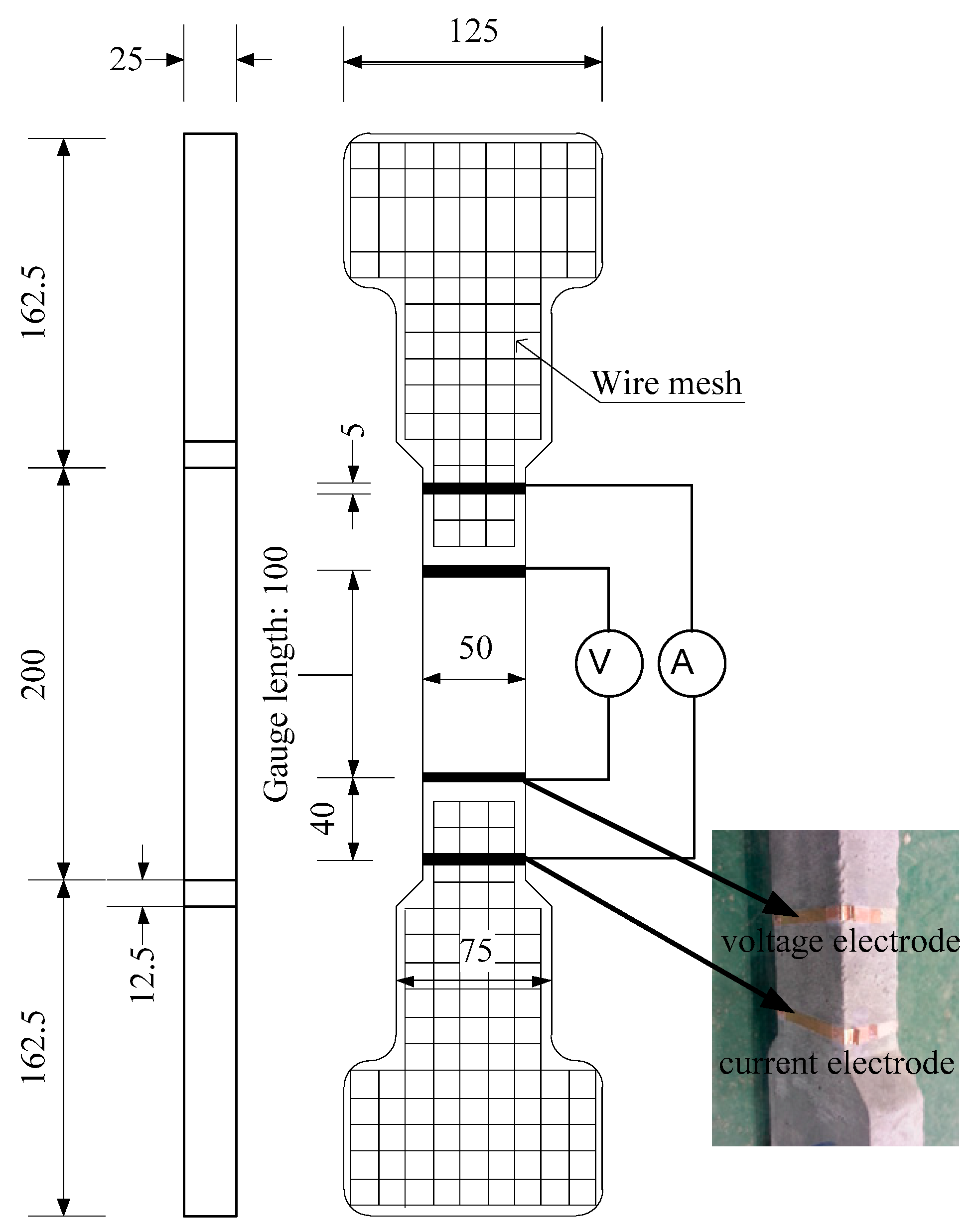
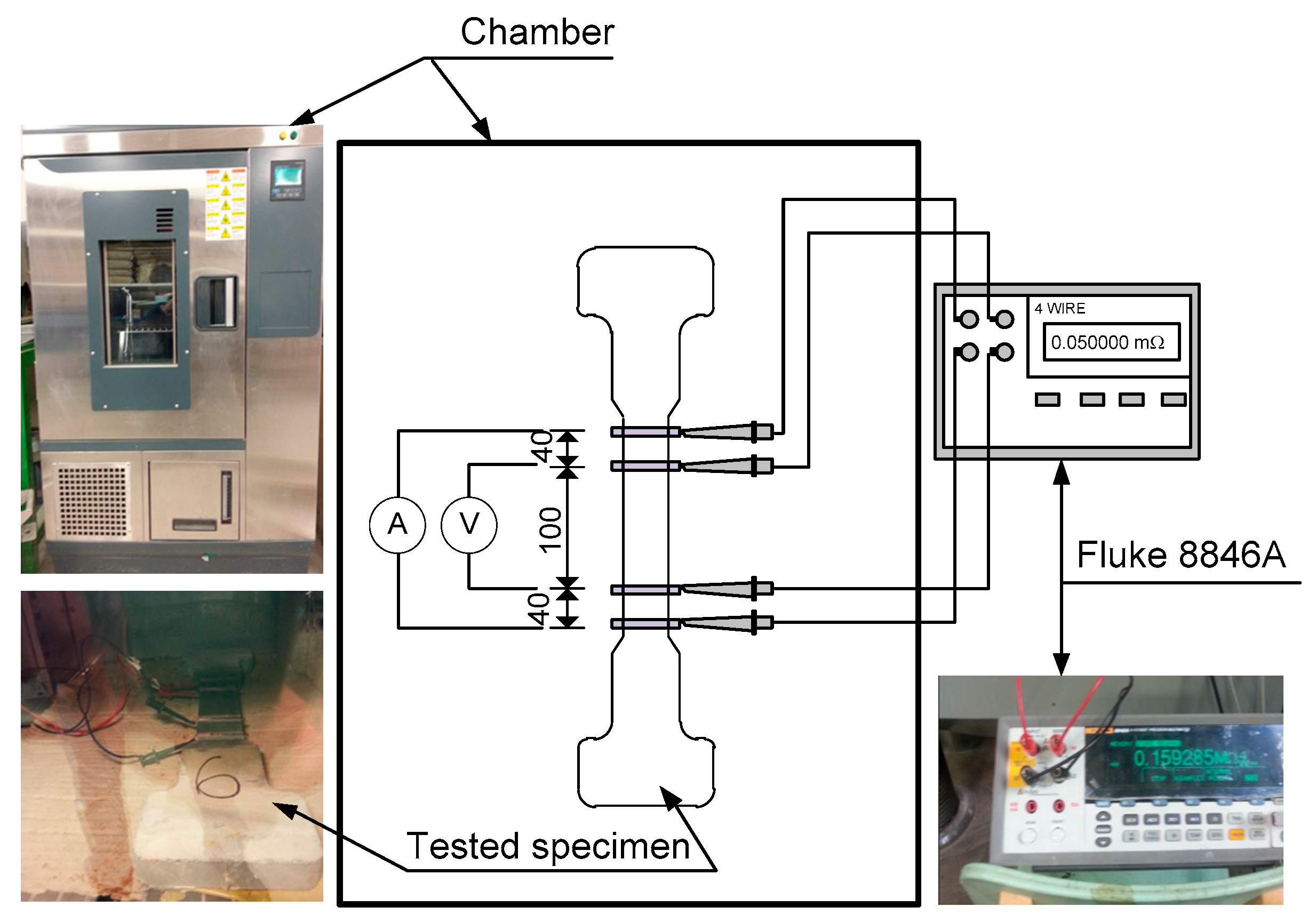

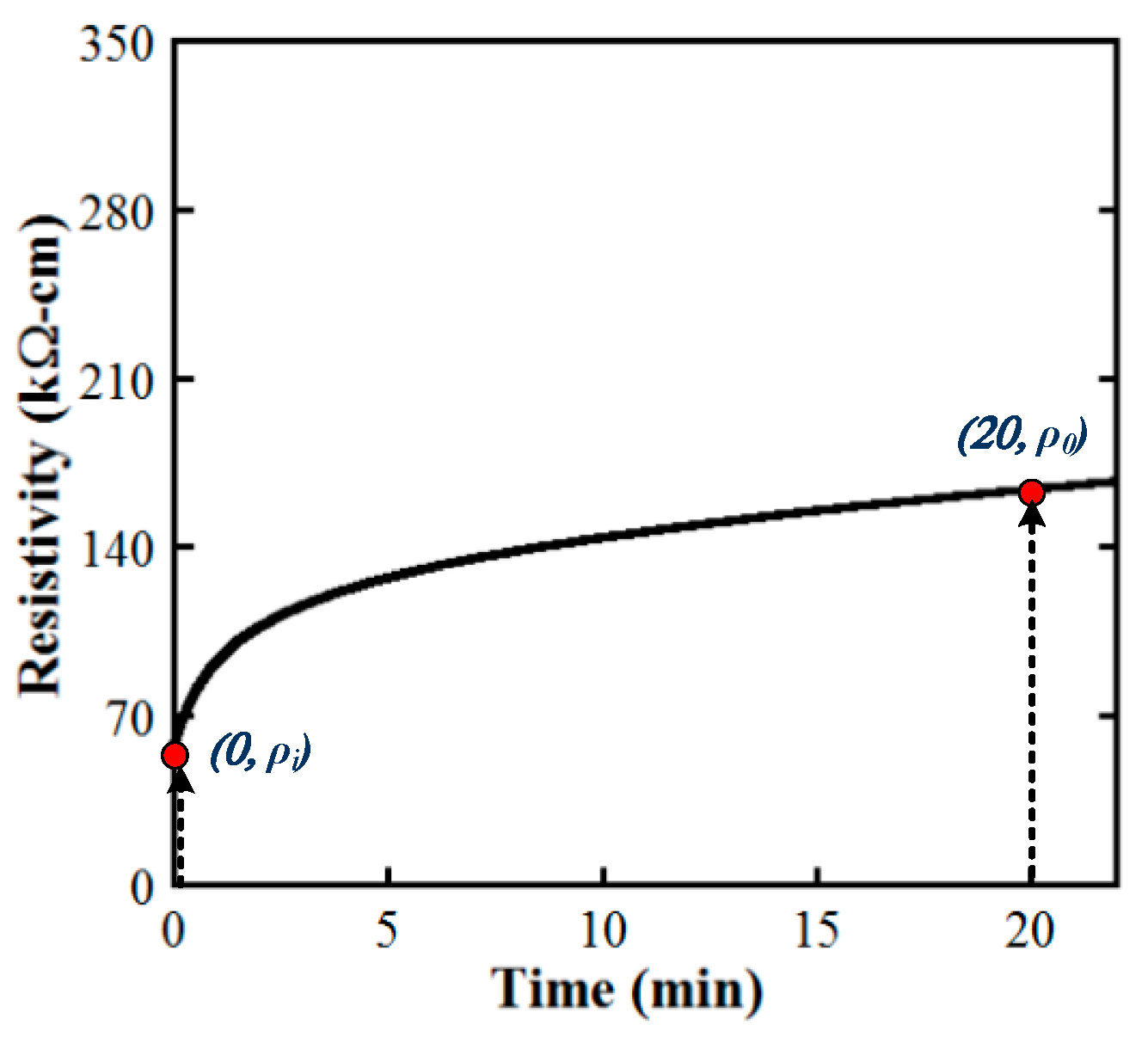

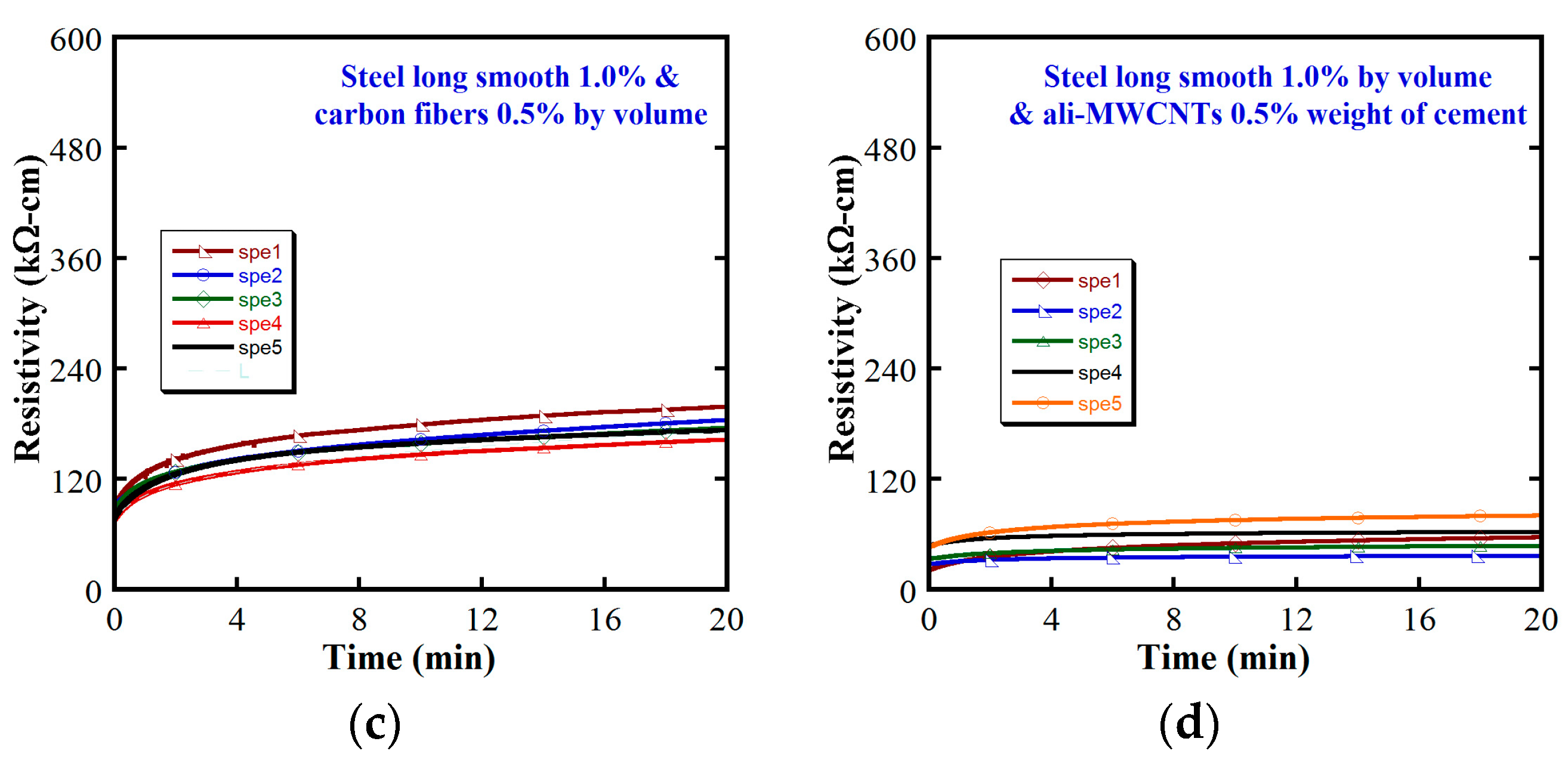
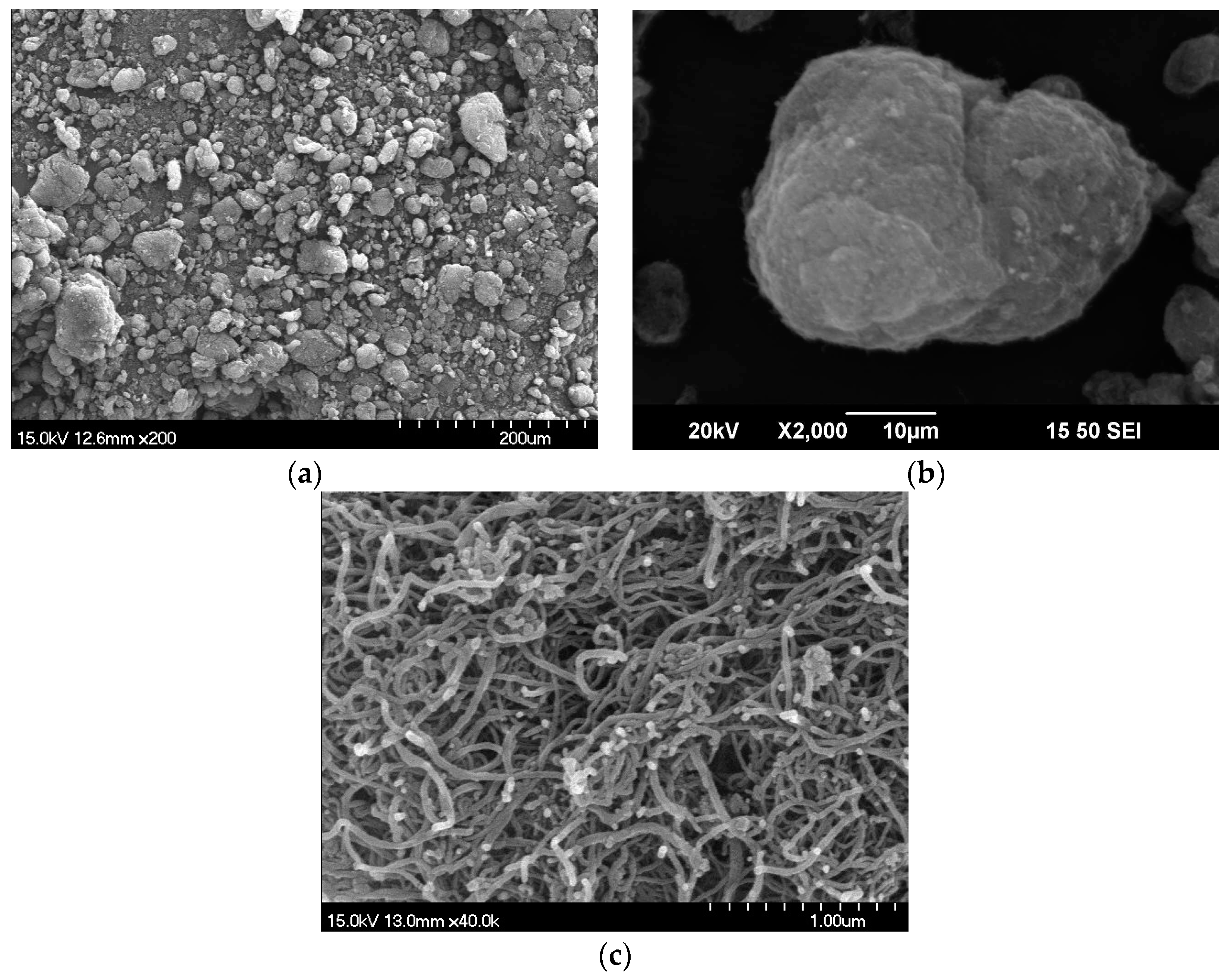
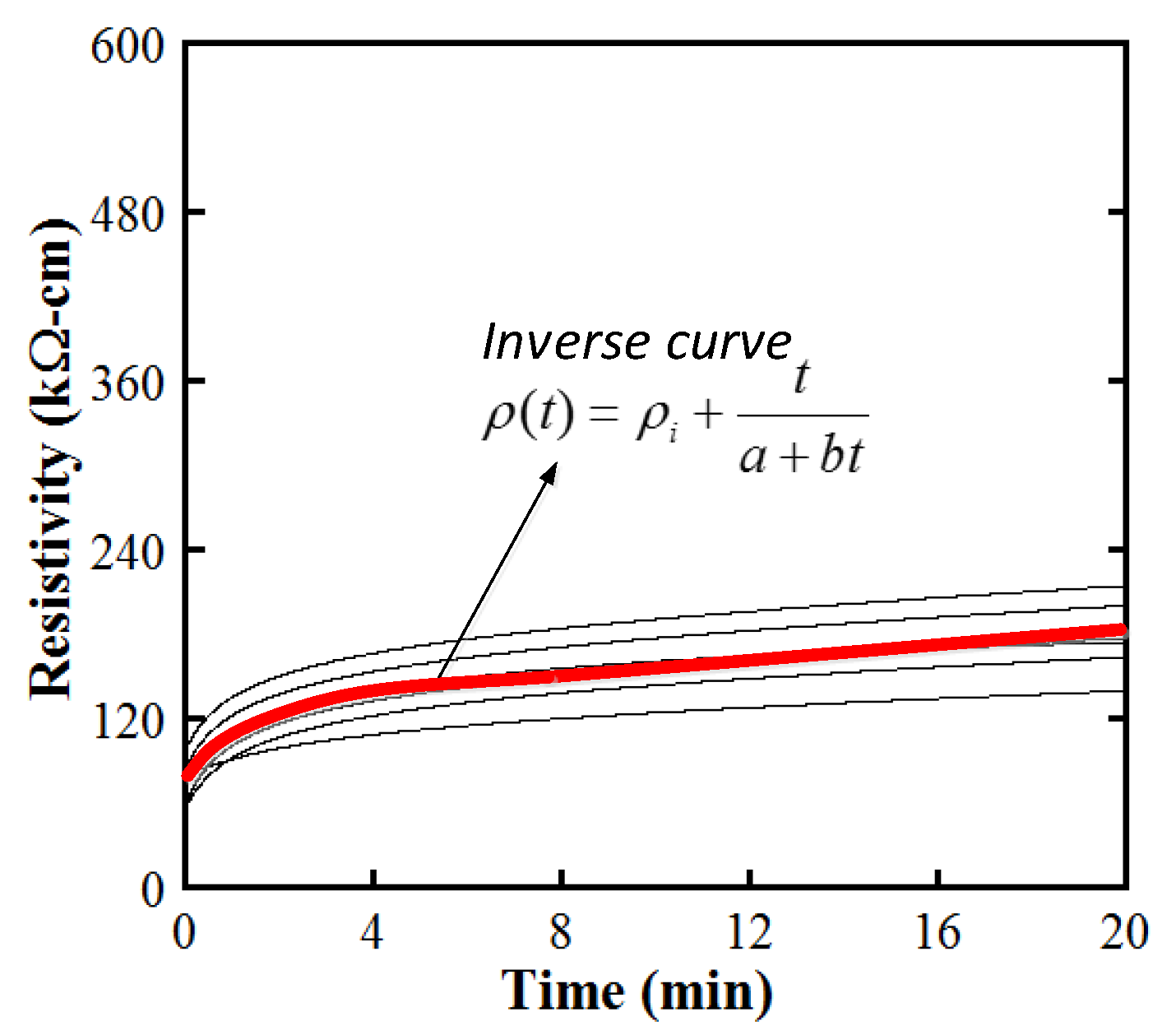
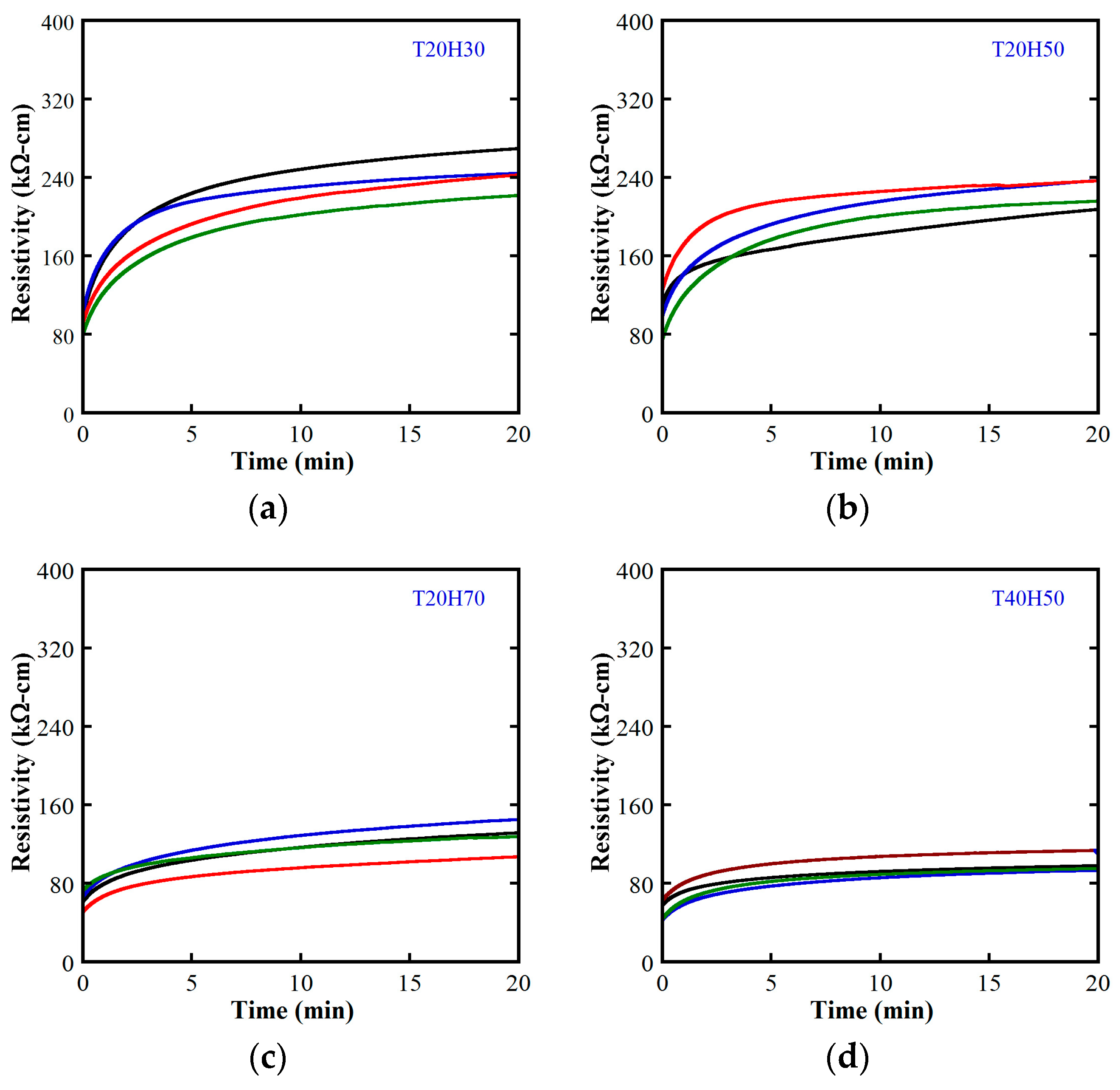
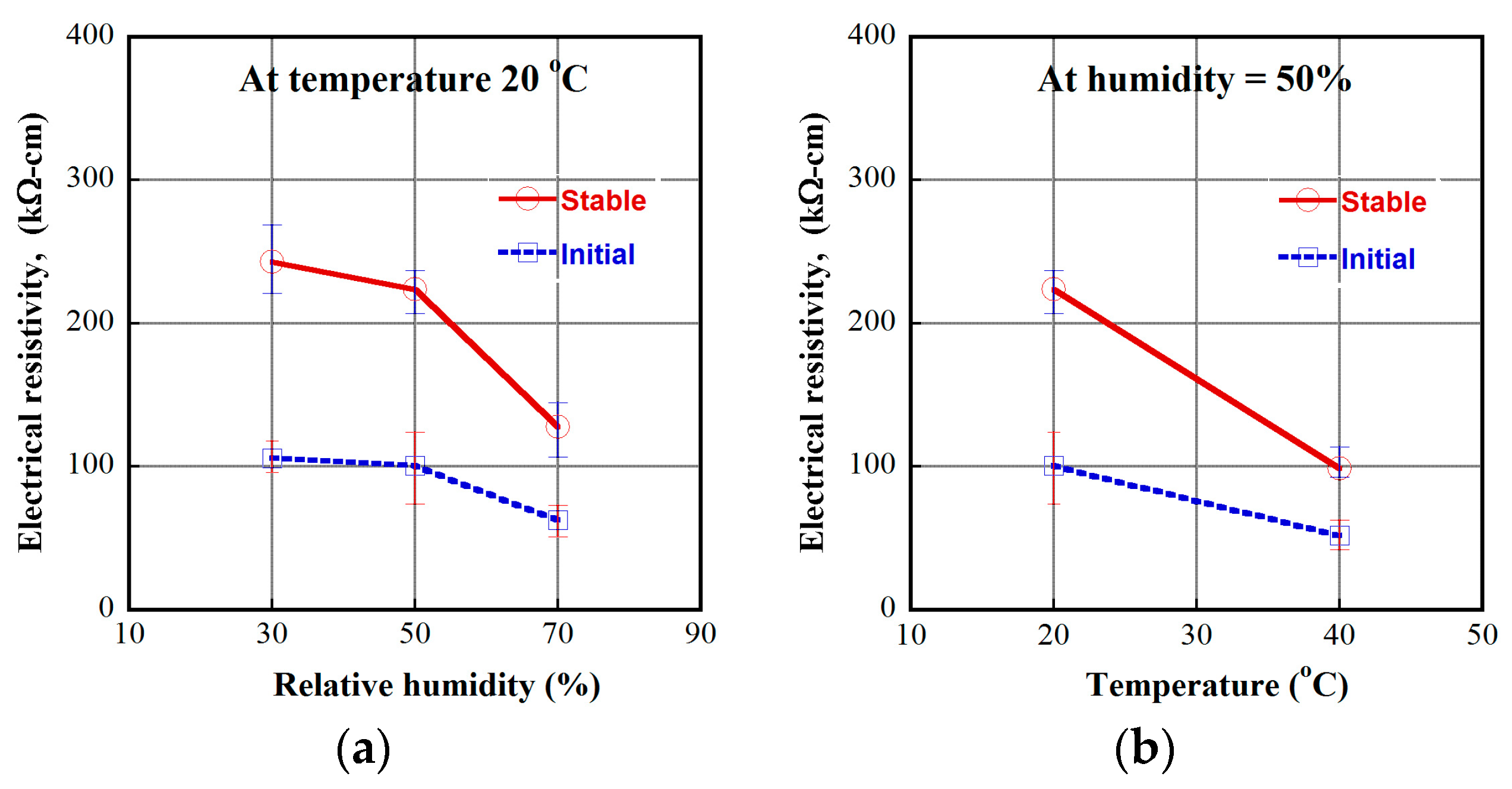
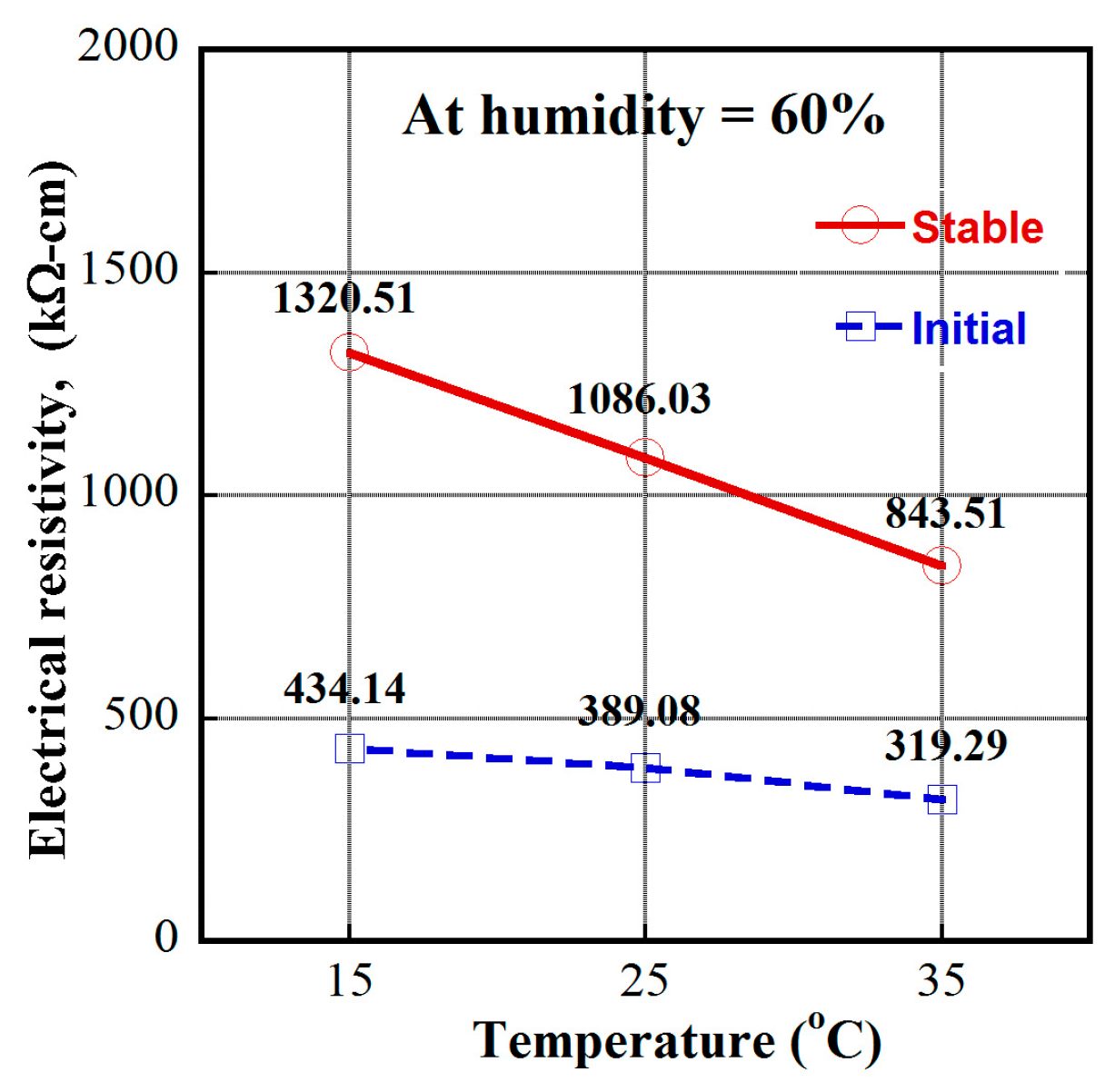
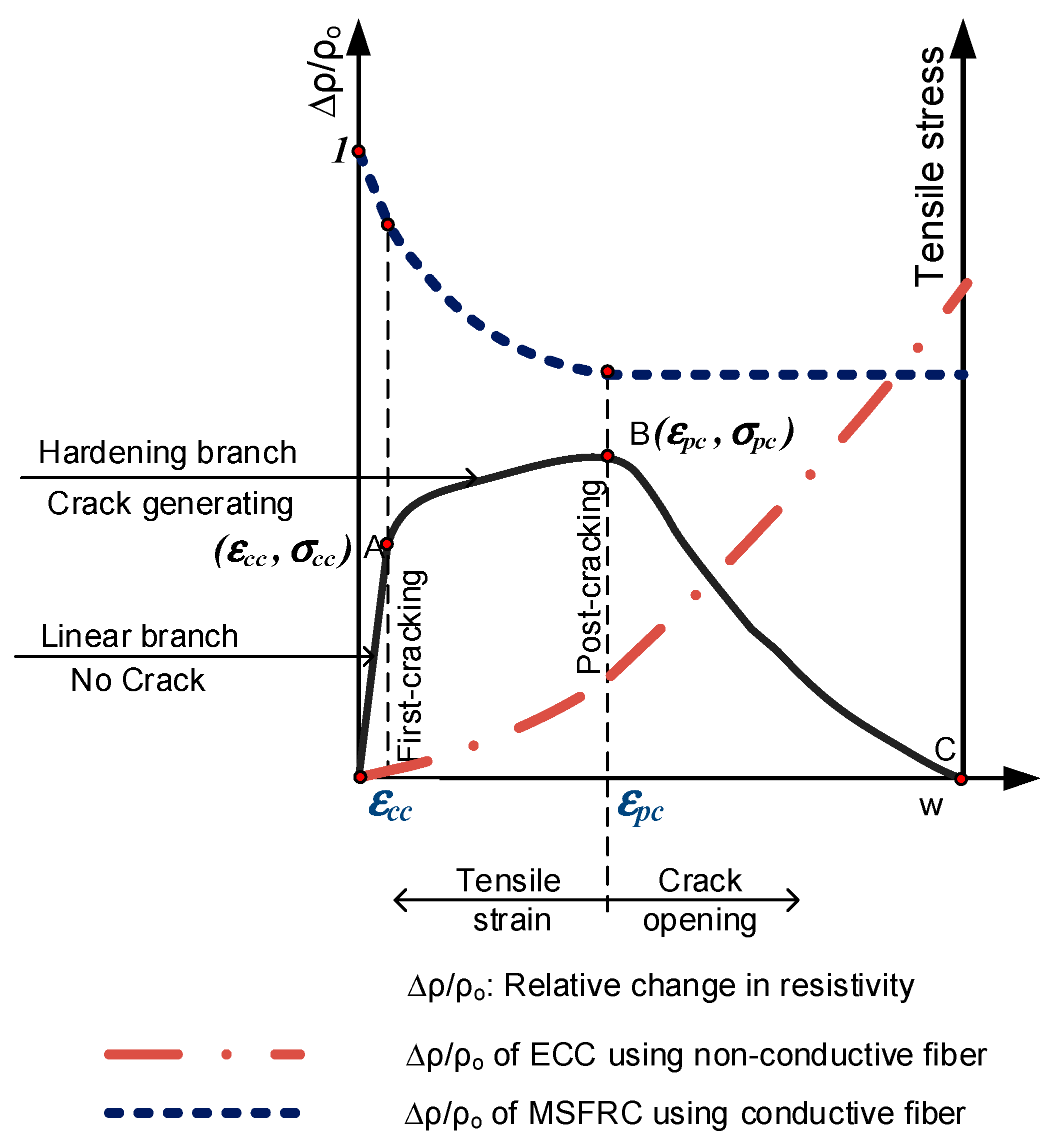
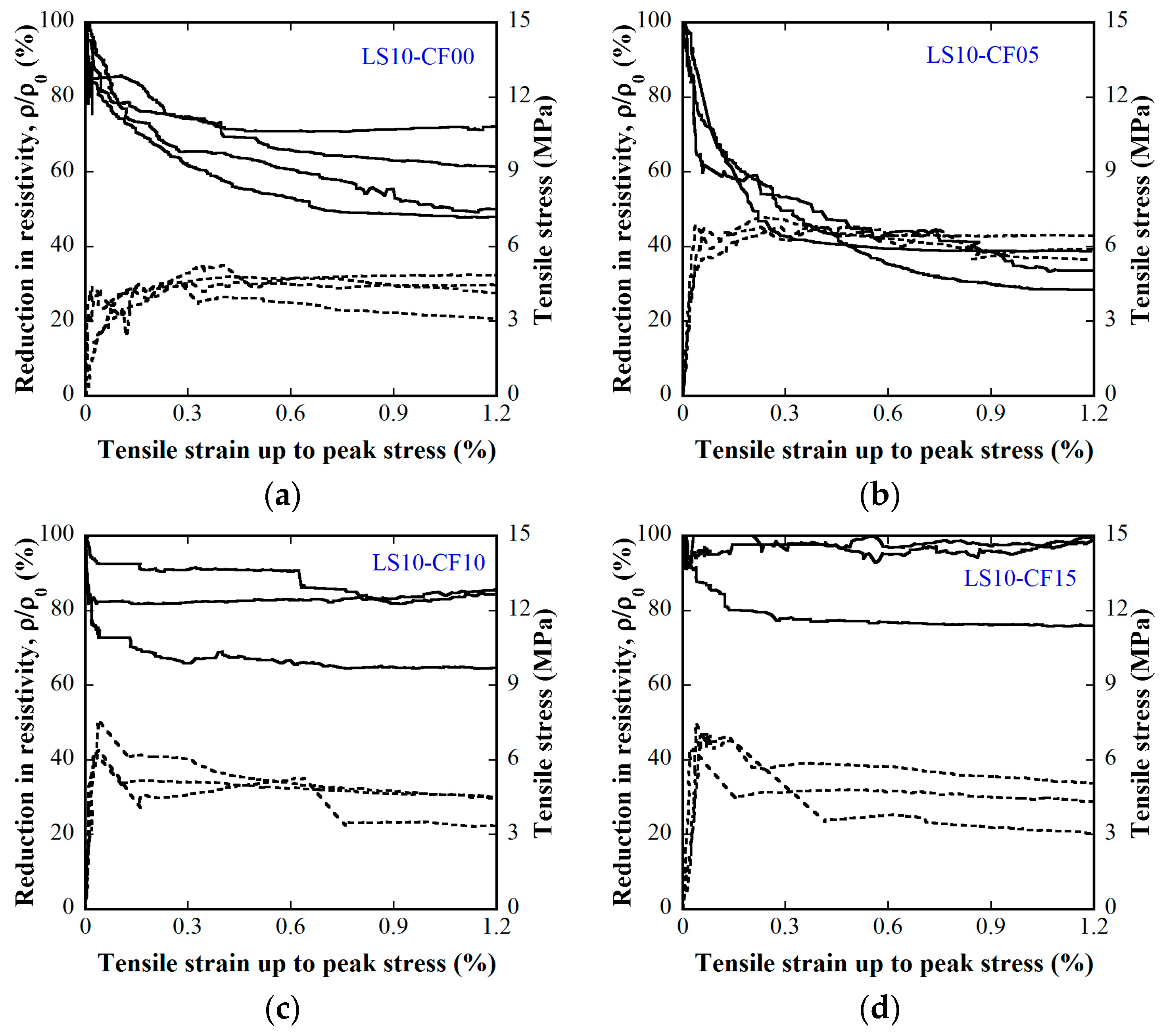
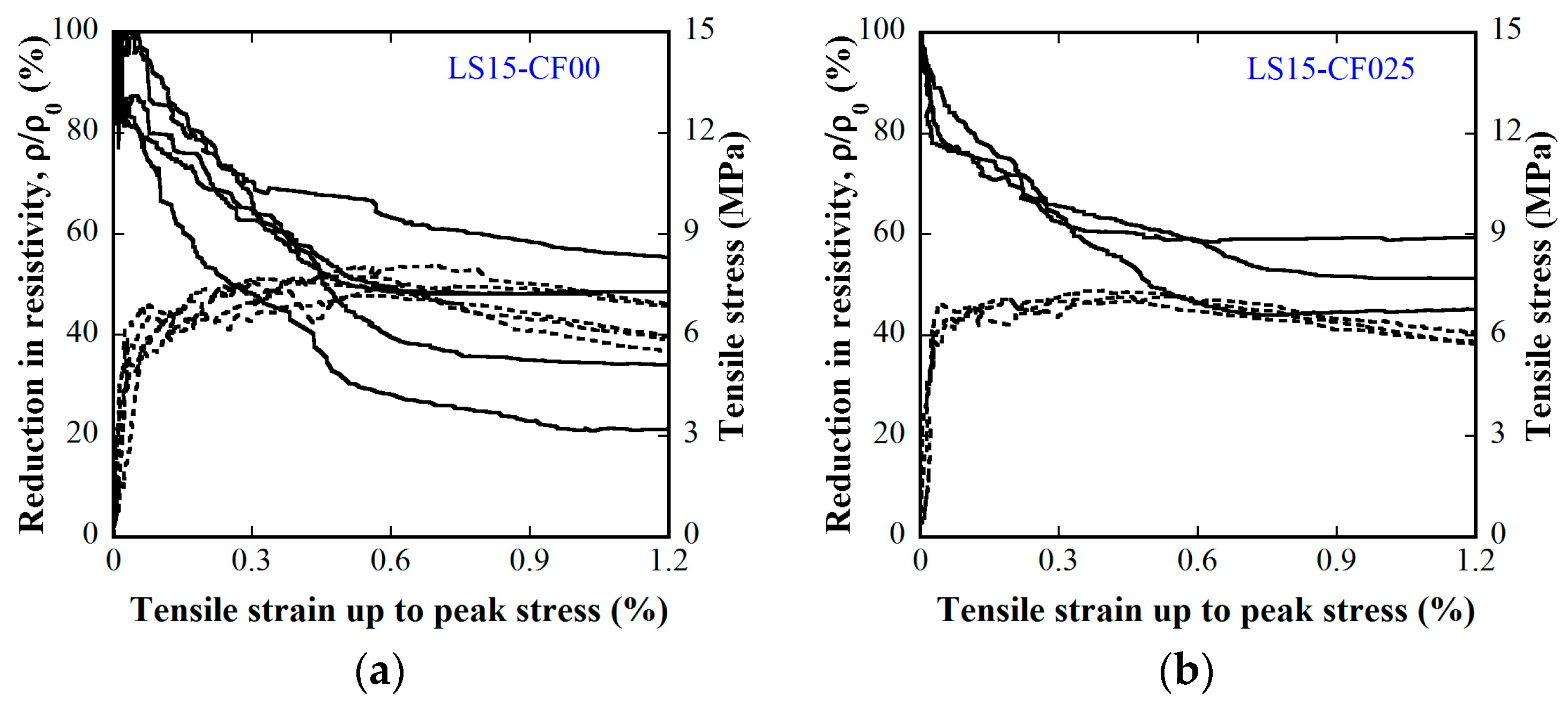
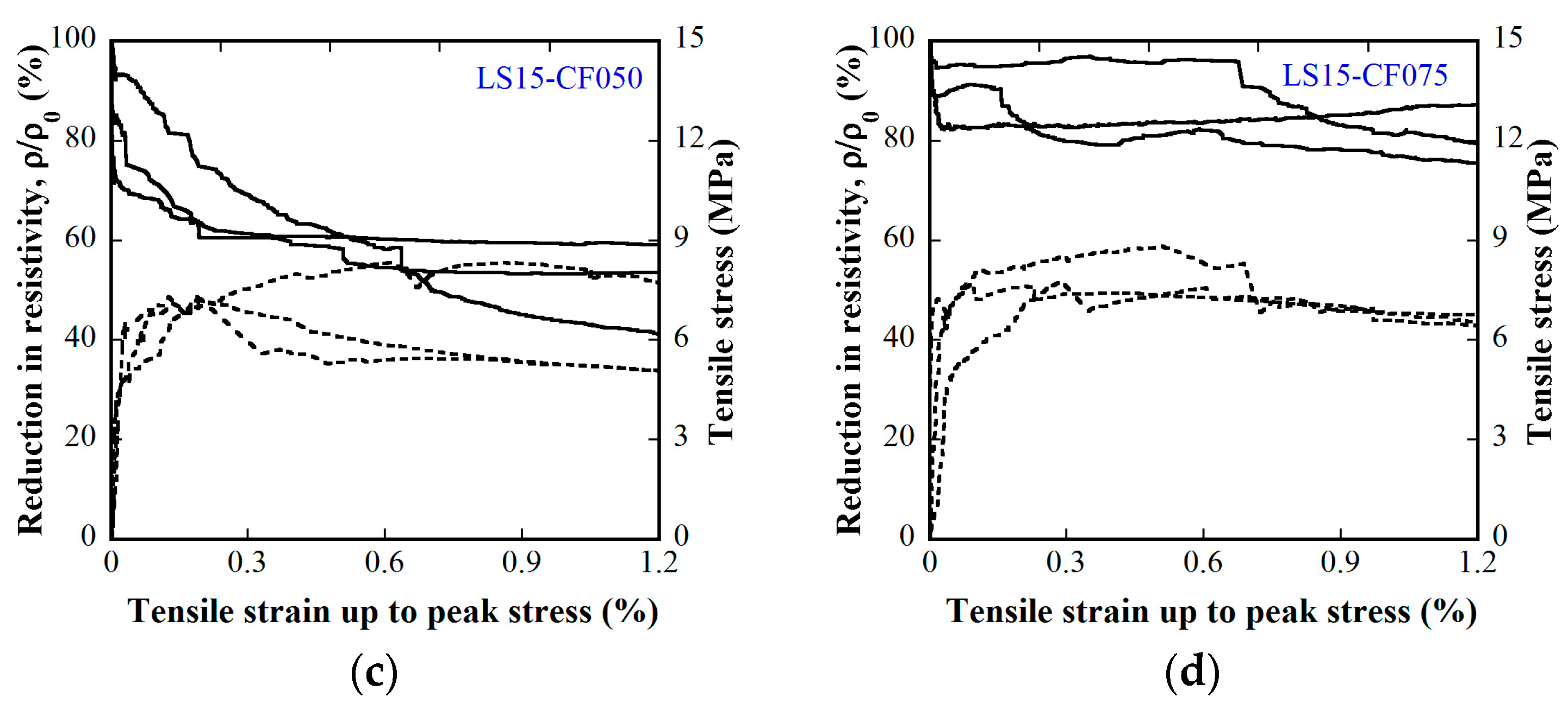
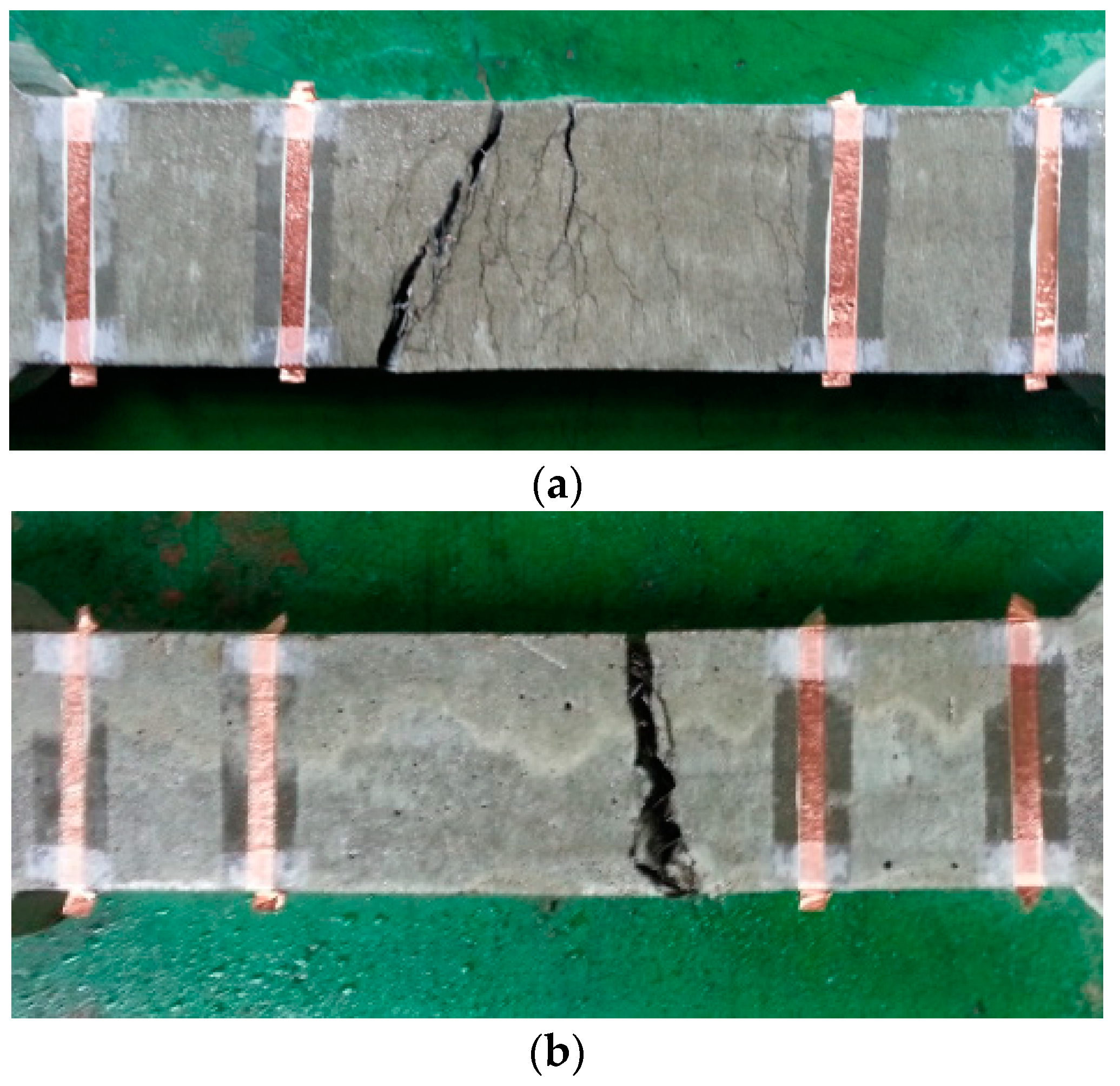
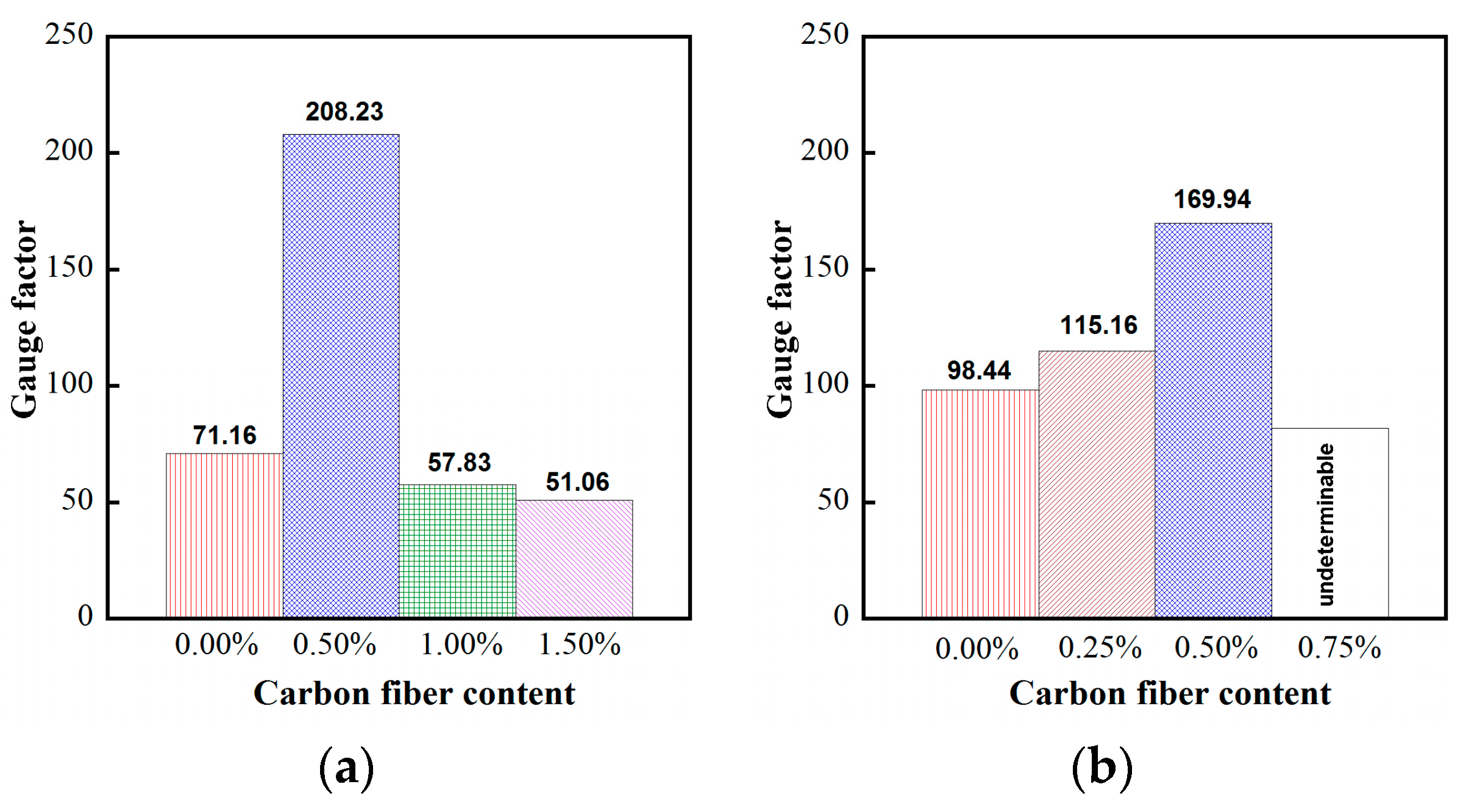

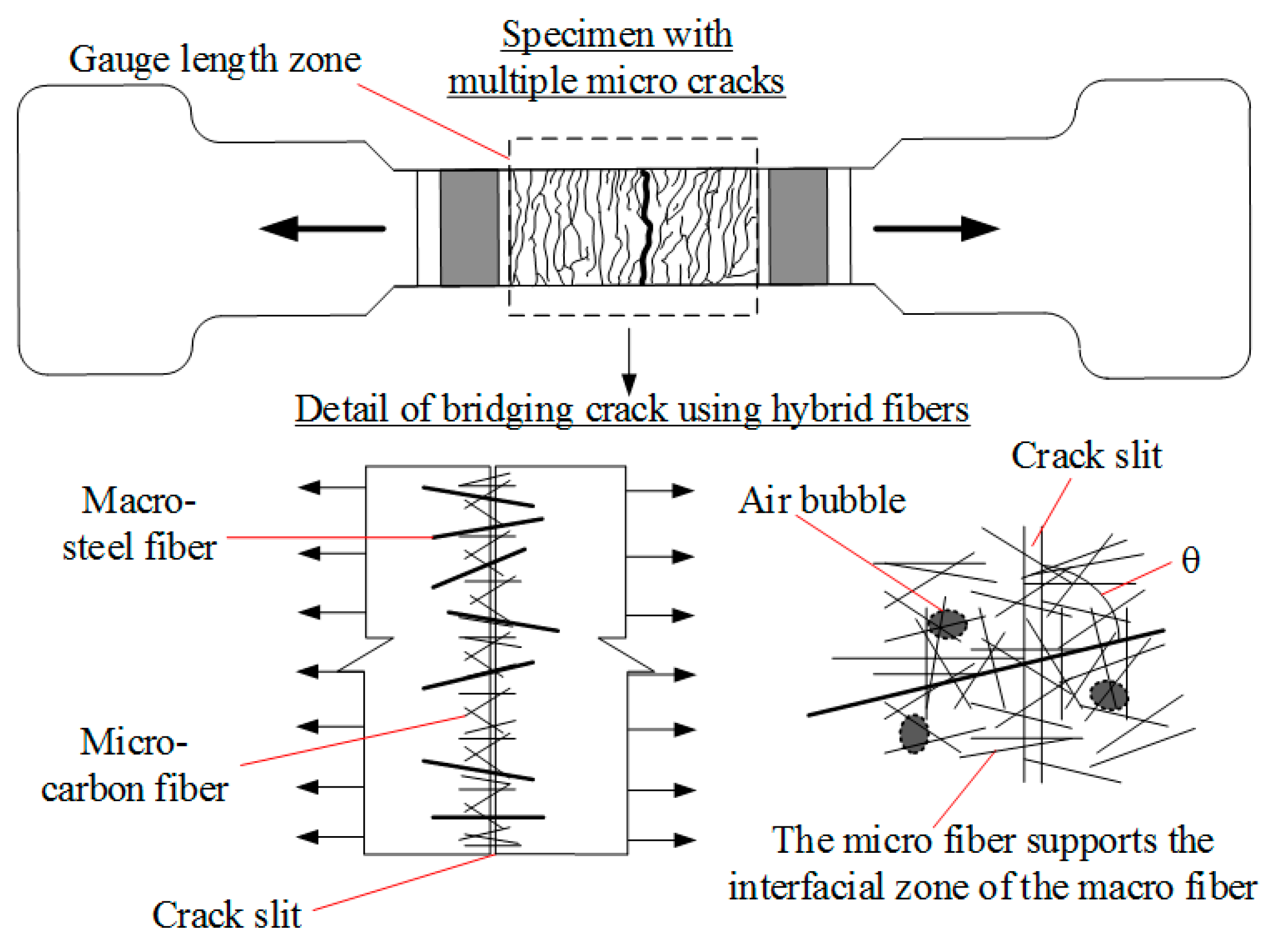

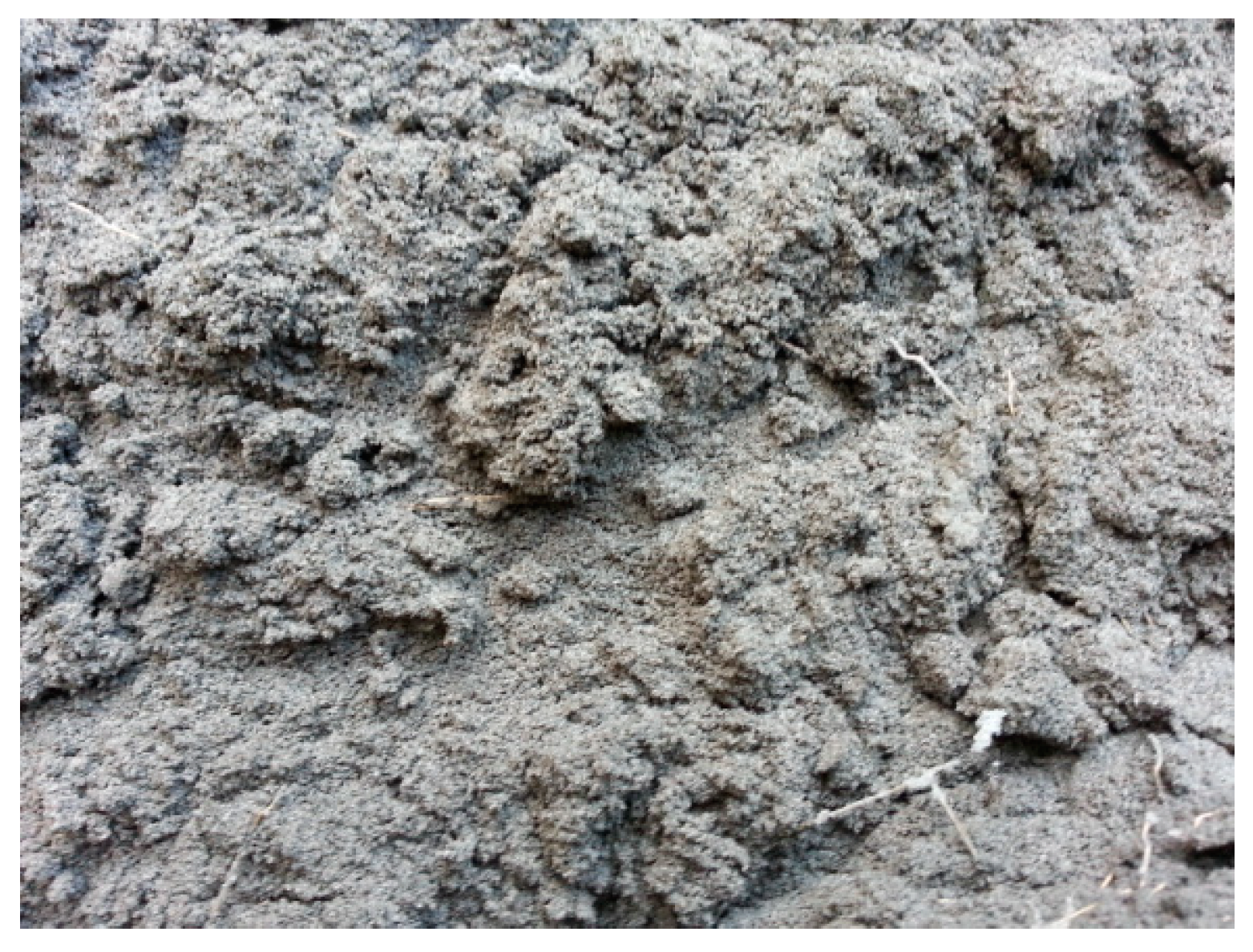
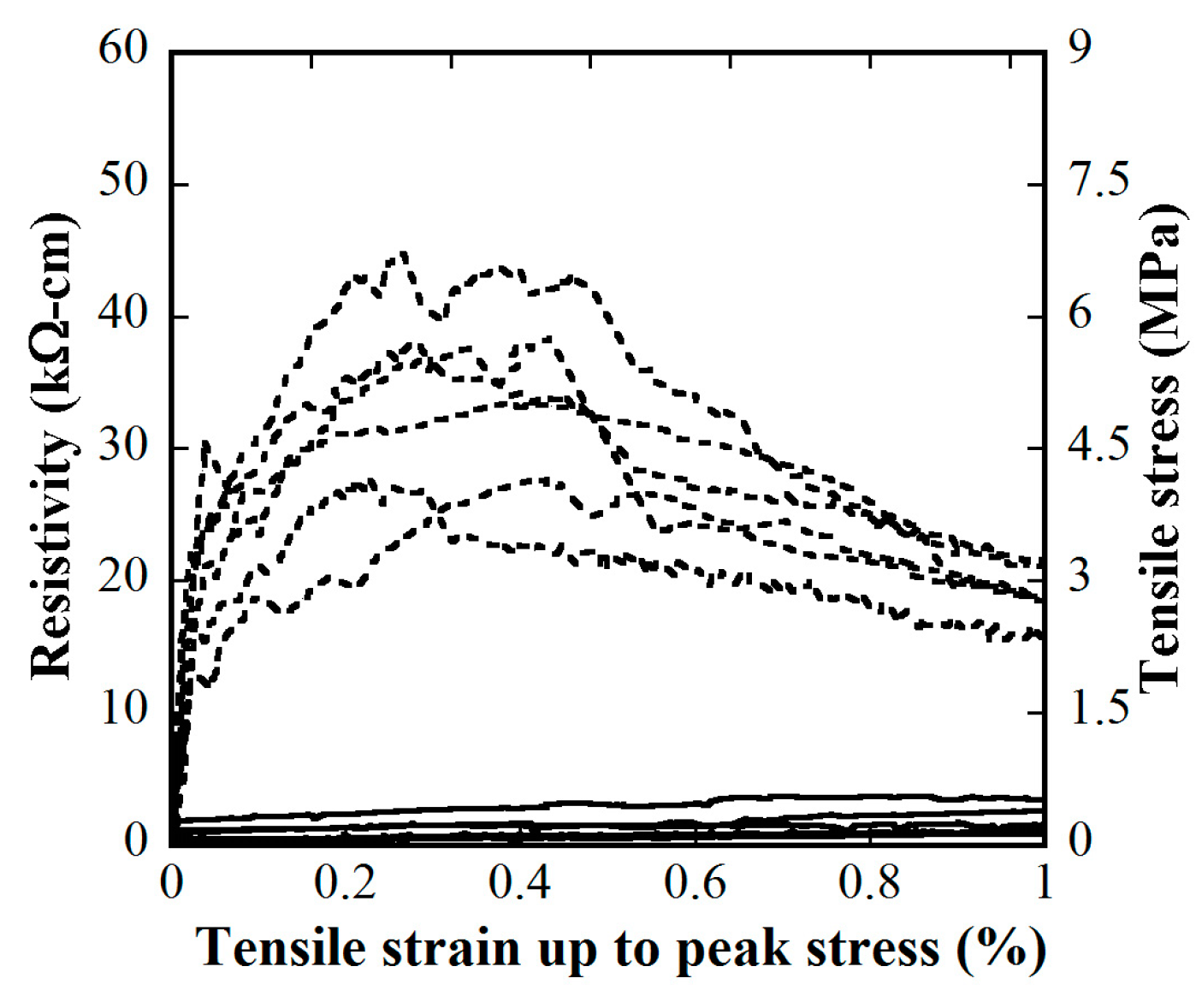
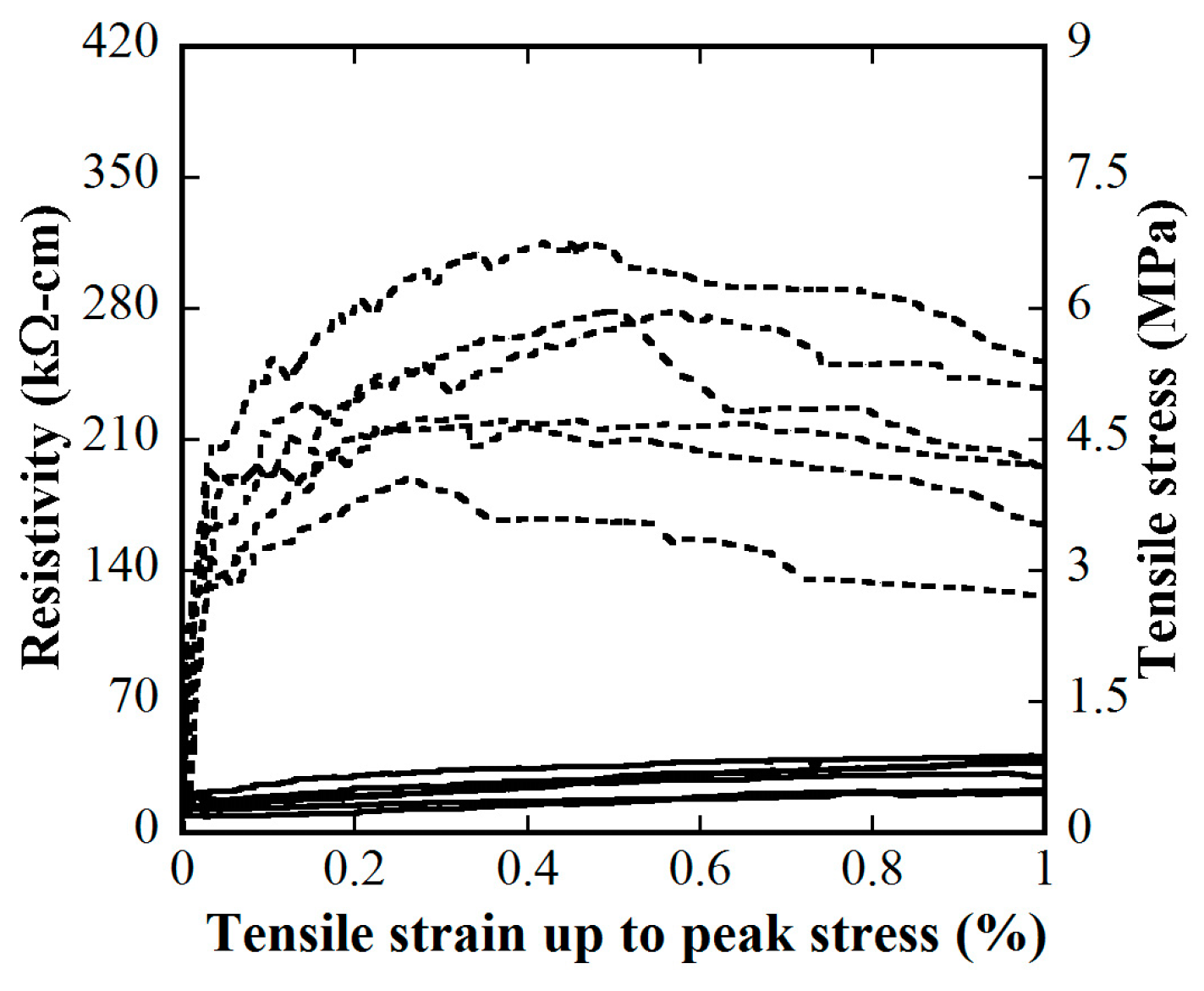
| Cement (Type 3) | Silica Fume | Silica Sand | Fly Ash | Superplasticizer | Water | fc’ (MPa) |
|---|---|---|---|---|---|---|
| 0.80 | 0.07 | 1.00 | 0.20 | 0.04 | 0.26 | 90 |
| Parameters | Micro-carbon Fiber | Macro-steel Smooth Fiber Fiber |
|---|---|---|
| Product origin | Panex35 (Korea) | JKT (Korea) |
| Diameter (mm) | 0.0072 | 0.3 |
| Length (mm) | 12 | 30 |
| Aspect ratio (Length/Diameter) | 1667 | 100 |
| Density (g/cc) | 1.81 | 7.9 |
| Tensile strength (MPa) | 4137 | 2580 |
| Elastic modulus (GPa) | 240 | 200 |
| Electrical resistivity (kΩ-cm) | 1.2 | 2.06 × 10−8 |
| Parameters | Value |
|---|---|
| Product origin | Hanwha (Korea) |
| Purity (wt.%) | >90 |
| Bulk density (g/cc) | 0.065 |
| Aspect ratio | 2000 |
| Diameter (nm) | 10~15 |
| Length (μm) | 30~40 |
| Number of wall | 10~15 |
| Ash (catalyst residue, %) | 10% |
| Surface area (m2/g) | ~1200 |
| Type of MSFRC | ρi (kΩ-cm) | ρ0 (kΩ-cm) | Ratio ρ0/ρi | ||
|---|---|---|---|---|---|
| Average Value | Standard Deviation | Average Value | Standard Deviation | ||
| Plain mortar without fiber and powder | 458.60 | 44.83 | 475.84 | 48.99 | 1.04 |
| Steel smooth 1.5 vol.% | 76.28 | 16.70 | 178.15 | 26.48 | 2.34 |
| Steel smooth 1.0% & CF 0.5 vol.% | 82.06 | 6.68 | 177.36 | 12.45 | 2.16 |
| Steel smooth 1.0 vol.% & MWCNTs 0.5 wt.% of cement | 39.10 | 11.73 | 65.99 | 15.57 | 1.69 |
| Type of MSFRC | Normalized, ρi | Normalized, ρ0 |
|---|---|---|
| Plain mortar without fiber & powder | 1 | 1 |
| Steel smooth 1.5 vol.% | 0.17 | 0.37 |
| Steel smooth 1.0% & CF 0.5 vol.% | 0.18 | 0.37 |
| Steel smooth 1.0 vol.% & MWCNTs 0.5 wt.% of cement | 0.09 | 0.14 |
| Environmental Condition | ρi (kΩ-cm) | ρ0 (kΩ-cm) | ||
|---|---|---|---|---|
| Average Value | Standard Deviation | Average Value | Standard Deviation | |
| Temperature 20 °C, humidity 30% | 105 | 10.6 | 243 | 19.7 |
| Temperature 20 °C, humidity 50% | 101 | 21.4 | 224 | 14.0 |
| Temperature 20 °C, humidity 70% | 63 | 9.3 | 128 | 15.7 |
| Temperature 40 °C, humidity 50% | 52 | 10.3 | 99 | 10.2 |
| Notation | Post-Cracking Parameters | Estimated Number of Hybrid Fibers within Cross-Section | ||
|---|---|---|---|---|
| σpc (MPa) | εpc (%) | N2D | N3D | |
| LS1.0-CF0.0 | 4.73 | 0.42 | 113 | 88 |
| LS1.0-CF0.5 | 6.51 | 0.45 | 97837 | 76841 |
| LS1.0-CF1.0 | 4.82 | 0.28 | 195562 | 153594 |
| LS1.0-CF1.5 | 4.64 | 0.35 | 293287 | 230347 |
| LS1.5-CF0.0 | 7.53 | 0.44 | 169 | 133 |
| LS1.5-CF0.25 | 7.19 | 0.37 | 49031 | 38509 |
| LS1.5-CF0.5 | 7.21 | 0.22 | 97894 | 76886 |
| LS1.5-CF0.75 | 6.79 | 0.29 | 146756 | 115262 |
| No. | Fiber used: Type, Aspect Ratio (mm/mm), Volume Content [ref.] | GF | Matrix | Post-Cracking Strength (MPa) |
|---|---|---|---|---|
| 01 | Twisted, 30/0.3, 1.5% [14] | 138.09 | M1 | 10.00 |
| 02 | Smooth, 30/0.3, 1.5% [14] | 99.85 | M1 | 7.64 |
| 03 | Hooked, 30/0.375, 1.5% [14] | 88.50 | M1 | 6.72 |
| 04 | Twisted, 20/0.2, 1.5% [14] | 139.68 | M1 | 10.99 |
| 05 | Smooth, 19/0.2, 1.5% [14] | 99.70 | M1 | 8.05 |
| 06 | Twisted, 30/0.3, 0.5% [15] | 87.26 | M1 | 4.86 |
| 07 | Twisted, 30/0.3, 1.0% [15] | 155.99 | M1 | 7.48 |
| 08 | Twisted, 30/0.3, 1.5% [15] | 164.24 | M1 | 9.99 |
| 09 | Twisted, 30/0.3, 2.0% [15] | 156.54 | M1 | 12.53 |
| 10 | Smooth, 30/0.3, 1.0% & Carbon, 12/0.0072, 0.5% [this study] | 208.23 | M1 | 6.51 |
| 11 | Smooth, 30/0.3, 1.5% [this study] | 98.44 | M1 | 7.53 |
| 12 | Smooth, 30/0.3, 1.5% & Carbon, 12/0.0072, 0.25% [this study] | 115.16 | M1 | 7.19 |
| 13 | Smooth, 30/0.3, 1.5% & Carbon, 12/0.0072, 0.5% [this study] | 169.94 | M1 | 7.21 |
| 14 | Smooth, 30/0.3, 1.0% & Smooth, 19/0.2, 1.0% [16] | 73.22 | M1 (*) | 12.37 |
| 15 | Smooth, 30/0.3, 1.0% & Smooth, 19/0.2, 1.0% [16] | 39.88 | M2 (**) | 15.13 |
© 2019 by the authors. Licensee MDPI, Basel, Switzerland. This article is an open access article distributed under the terms and conditions of the Creative Commons Attribution (CC BY) license (http://creativecommons.org/licenses/by/4.0/).
Share and Cite
Nguyen, D.-L.; Kim, D.-J.; Thai, D.-K. Enhancing Damage-Sensing Capacity of Strain-Hardening Macro-Steel Fiber-Reinforced Concrete by Adding Low Amount of Discrete Carbons. Materials 2019, 12, 938. https://doi.org/10.3390/ma12060938
Nguyen D-L, Kim D-J, Thai D-K. Enhancing Damage-Sensing Capacity of Strain-Hardening Macro-Steel Fiber-Reinforced Concrete by Adding Low Amount of Discrete Carbons. Materials. 2019; 12(6):938. https://doi.org/10.3390/ma12060938
Chicago/Turabian StyleNguyen, Duy-Liem, Dong-Joo Kim, and Duc-Kien Thai. 2019. "Enhancing Damage-Sensing Capacity of Strain-Hardening Macro-Steel Fiber-Reinforced Concrete by Adding Low Amount of Discrete Carbons" Materials 12, no. 6: 938. https://doi.org/10.3390/ma12060938





